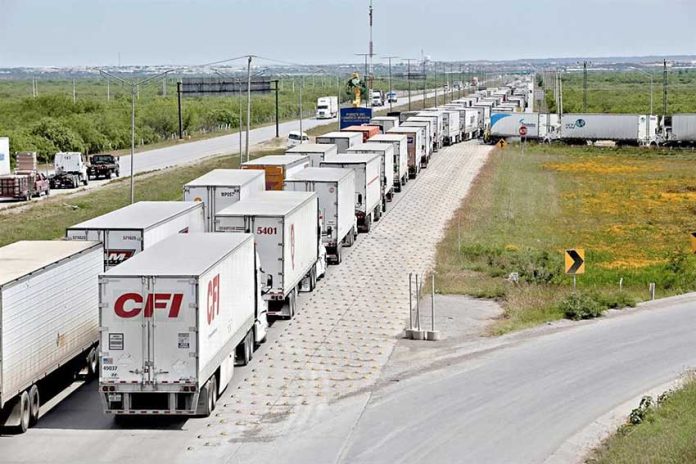Cars and trucks are facing long wait times at several border crossings between Mexico and the United States as a result of a decision to redeploy U.S. border officials to deal with a massive number of migrants.
Drivers are having to wait for up to 10 hours to cross between Ciudad Juárez, Chihuahua, and El Paso, Texas, where long lines in the former are generating chaos and congestion on several main avenues, the newspaper El Universal reported.
Around 350 semi-trailers packed with products manufactured at local factories have been waiting to cross the border since before 1:00am, El Diario de Juárez said.
To reduce the discomfort of motorists trapped in their vehicles for such long periods, Ciudad Juárez authorities have placed portable toilets along the roads leading to the city’s three ports of entry to the United States.
While the media is reporting multi-hour waits to cross into El Paso, United States Custom and Border Protection (CBP) said this morning that the longest wait time at the three ports of entry was two hours at the Zaragoza International Bridge.
The delays follow a decision by CBP to withdraw personnel from official border crossings to help process an influx of migrants into the United States. Some lanes at ports of entry have been closed as a result.
Travelers at many other northern border crossings are also experiencing lengthy delays, while only Baja California ports of entry are operating normally.
Capufe, the federal agency responsible for bridges and highways, reported waits of between two and seven hours for motorists attempting to enter the United States from Reynosa, Nuevo Laredo and Matamoros in Tamaulipas and Piedras Negras and Ciudad Acuña in Coahuila.
“They [CBP] are working at 40% [capacity] . . . The Tamaulipas border is half-closed,” said Julio Almanza, president of the Tamaulipas Federation of Chambers of Commerce, Services and Tourism.
Wait times at Nuevo Laredo averaged seven hours yesterday, while all car lanes on the Reynosa-Pharr International Bridge were closed for several hours to allow trucks that had been stranded since Monday to enter the United States.
A protest by Tamaulipas farmers made matters worse. They blocked the port of entry for eight hours on Monday in a campaign calling for more government assistance.
There are fears that congestion at the border will only worsen in the coming weeks as cross-border traffic spikes for the Easter vacation period.
Meanwhile, United States President Donald Trump renewed his threat this morning to close the border but instead of ordering Mexican authorities to do more to stem illegal immigration, he urged the U.S. Congress to support his border plans.
“Congress must get together and immediately eliminate the loopholes at the border! If no action, border, or large sections of border, will close. This is a national emergency!” he wrote on Twitter.
If the border were to close completely, Mexico’s losses in trade revenue could reach as high as US $808.8 million a day.
The figure is based on data from the United States Department of Transport that shows that Mexican exports to the U.S via land borders were worth US $295.2 billion in 2018.
“The impact would be tremendous,” said Francisco Cervantes, president of the Confederation of Industrial Chambers (Concamin).
Pedro Chavira, president of the Chihuahua branch of the National Council of the Maquiladora Industry (Index Nacional), said that huge losses have already been incurred due to the delays at border crossings but claimed that it was impossible to quantify the exact amount.
President López Obrador addressed Trump’s threat to close the border during this morning’s press conference.
“The closure of borders is not in the interest of anyone,” he said.
“It’s not the most advisable thing. I’m pleased that the government of the United States is now recognizing that we are helping [on migration] and we’re going to continue to do it . . .”
Source: El Universal (sp), El Diario (sp), El Mañana (sp), Reforma (sp), Valley Central (en)
